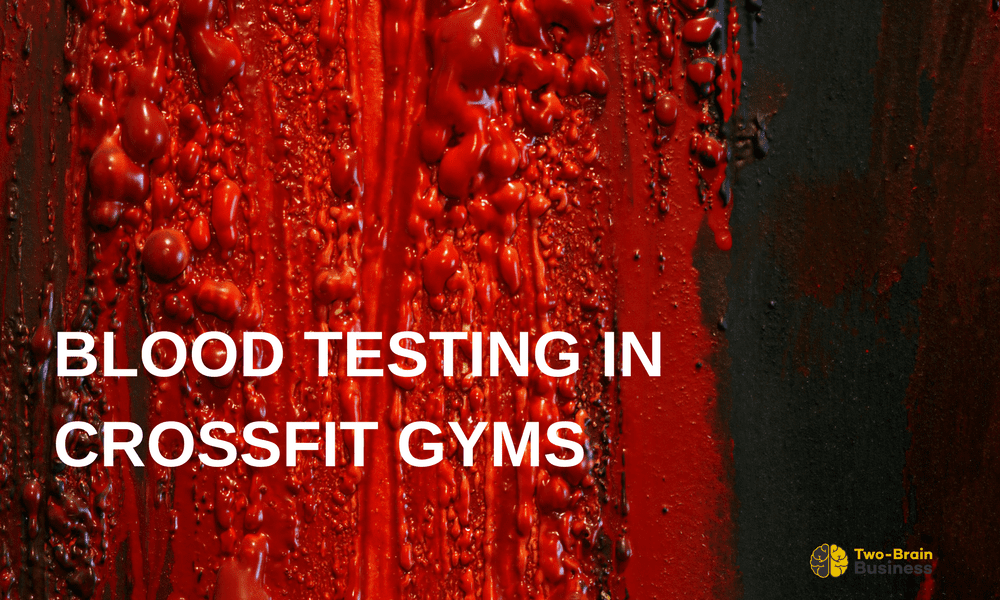CrossFit effects its clients on every level.
We know, from dozens of stories, that coaches have the unparalleled potential to change cholesterol, blood sugar, cortisol and a host of other blood marker levels.
But how can blood testing potentially affect the business of coaching?
In early December, we decided to find out. Members of the TwoBrain mentoring team, as well as 10 coaches and clients from Catalyst, surrendered our blood to answer the question, “Could this help the clients of CrossFit gyms?”
I’m not the first one to experiment with blood testing in a gym. But my intention wasn’t to tweak the minute training of a Games athlete; mine was to answer the question, “Would this help CrossFit gyms keep members longer?”
First discovery: I’m not good at fasting. But I take the test more seriously because I’m forced to fast.
Clients and coaches lined up at 6:30am. I brought in a phlebotomist to take our blood. She set up a centrifuge in our Athletic Therapy office, and stacked rows of test tubes and syringes on my intake desk. The air in the waiting area was somber, as if we were waiting to see a doctor (and anticipating bad news). Most brought a snack for after the test; I already had my order in at the Workshop cafe next door.
It took around ten minutes per athlete. Then the phlebotomist packed up her things and the waiting began.
Second discovery: How I behave and think while wearing the client’s shoes.
Our results arrived a week later. An email notification arrives with “Your Blood Testing Results are Here!”
I clicked through, and away we went.
Here are some screen shots. I won’t share the name of the company we used outside the TwoBrain family, but you might catch a glimpse in the pictures.
My test was a full one; many of my coaches and all of my clients used a version around the $200 range, which wasn’t quite as comprehensive.
Most of my markers were in the “Optimized” range, so I’ll focus on the interesting ones–the “At Risk” markers.
Here’s how the 5 “At-Risk” markers were presented to me:
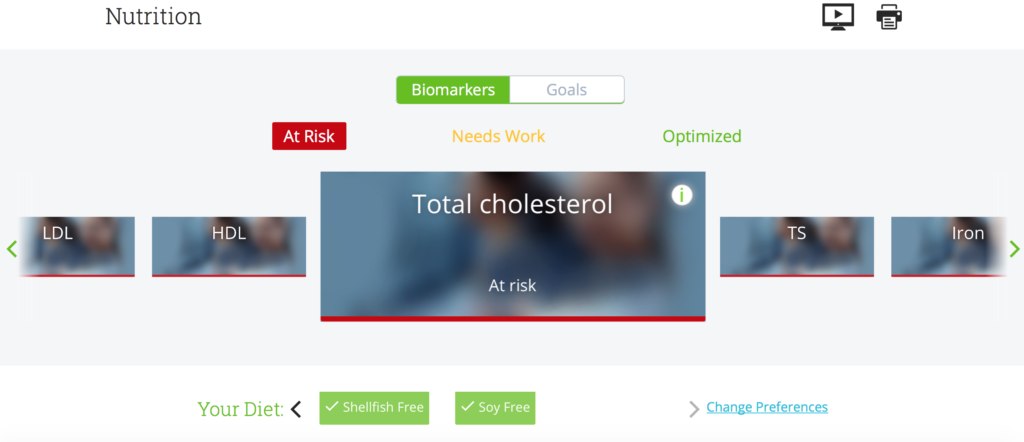
Nearly all were in the “Metabolism and Weight Control” category, so here’s a more detailed view of just those markers: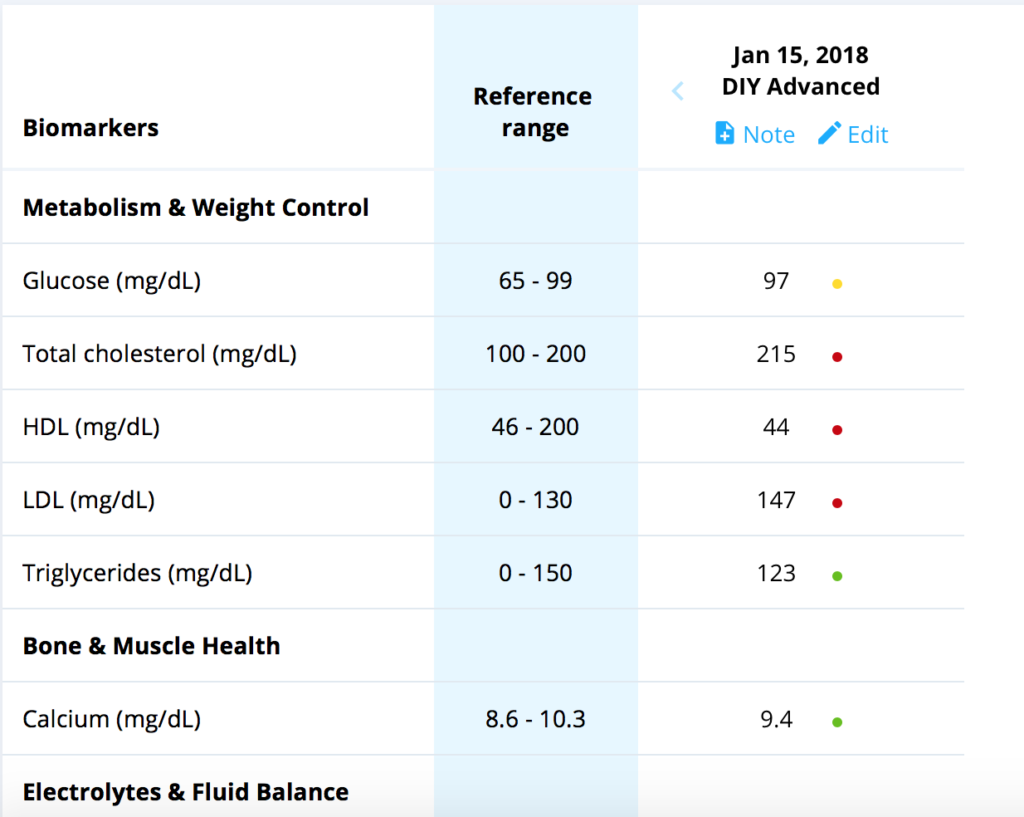
…if I clicked on the “LDL” picture above, I got this:
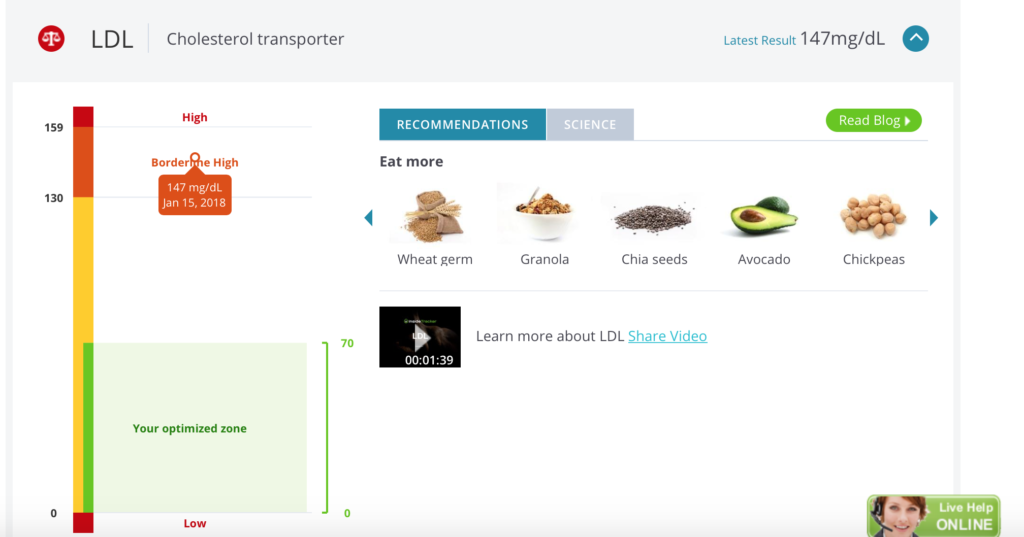
…and if I clicked “Shopping Basket”, foods and supplements that would help with my “At Risk” categories were sorted and prioritized this way:
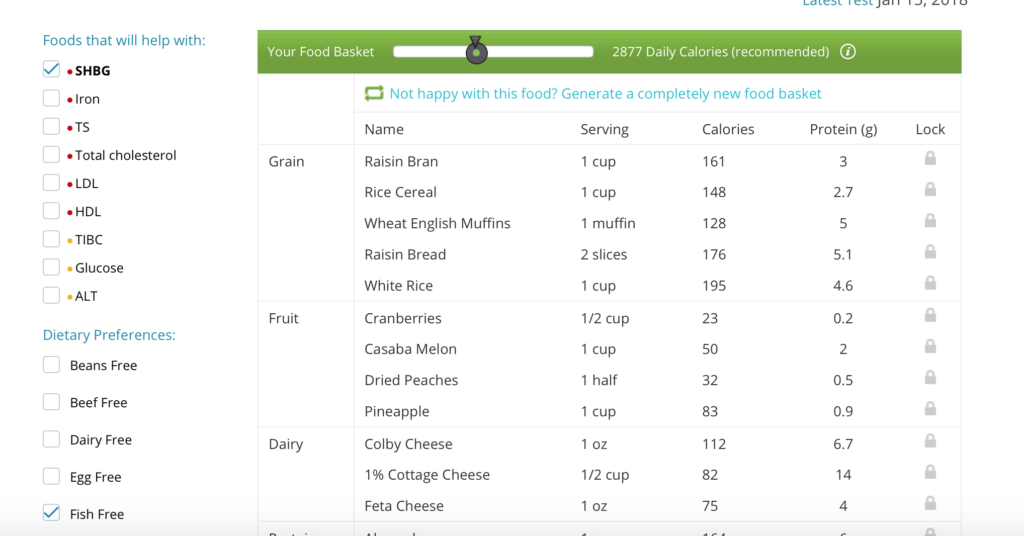
(I’m not sure why it says “Fish Free”, except during the intake survey I clicked that I only ate fish once per week or less. I don’t dislike fish, but my wife does, so we rarely eat it at home.)
Just for fun, I clicked the “Cognitive” link and saw this:
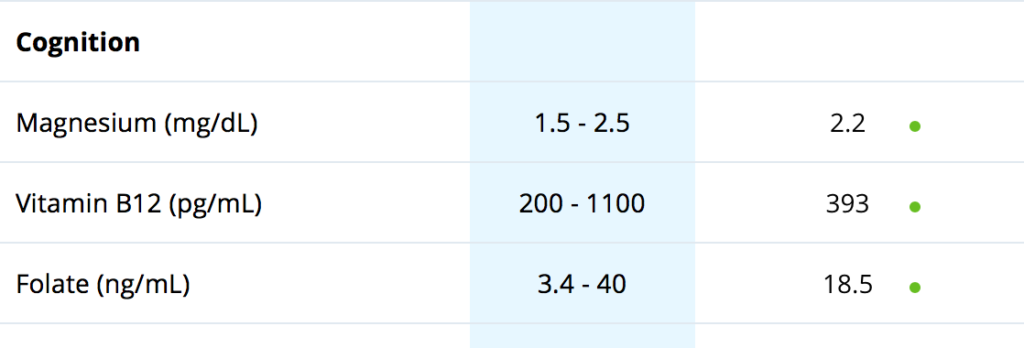
Nothing crazy. But being on the other end of the testing put me into the client’s shoes. And when I analyzed my own reactions later, I chuckled a bit.
My first response was to justify my current behavior instead of asking, “What do I have to change in my lifestyle to fix these numbers?”
LDL cholesterol and cortisol levels were both high. The tracking service suggested I cut back on the intensity of my workouts. Since I’ve been scaling most of them lately, they’re nowhere near my usual level of intensity. So I pointed the finger at my stress level.
Now, I’m not stressed out. But I’m very busy: we happily add 4 new gyms to the TwoBrain family every 3 days. We just released our 2018 curriculum for gym owners, and compiling data to support what we teach was a LOT of work. We have three massive R&D projects running at major expense. All good things (eustress) but still: all.of.the.things. Our gym went through a management restructuring around Christmas time, and while we now have all the right people in all the right seats, their learning curve puts demands on my time that I don’t really have.
So I rationalized: cortisol and LDL are high because of stress; this stressful period will eventually pass; I’ll just do nothing and wait it out. And that’s how a client would probably react.
Next, I asked what the “hacks” were to solving the problem. What supplement can I take? What can I eat MORE of (instead of asking myself, “where do I need to cut back?”) Now, my friend and UpCoach mentor Craig Hysell has changed my view on “hacks”, so I immediately realized I was trying to avoid change. But most clients wouldn’t.
Finally, I tried to use my tried-and-true avoidance technique: “I might be unhealthy, but this is the price I’m willing to pay to feed my family.” This is a sticky lie, and I know it. More sleep and more time skiing instead of working will make me a better husband, dad and mentor. So why am I writing this review at 4am, and then working on another big project this morning? I don’t know the answer, but I believe our clients will do the same things.
In other words, they need a coach.
Third discovery: I automatically trust the people who provide the data.
When the guys behind the software said “Eat more rolled oats”, my first thought was “Wow, I’ve been wrong about that for a full decade.” I immediately mistrusted what I knew about myself because these guys have white lab coats.
The Zone Diet works really well for me. I focus on cognitive performance instead of physical performance, because winning the Games doesn’t help other gym owners (but mental acuity does.) I don’t eat rolled oats in the morning because even small amounts make me less sharp.
But when presented even a shaky chain of logic (my LDL is high; high LDL is dangerous; LDL is best controlled by diet; people who eat more rolled oats have lower LDL) my knee-jerk reaction was to buy into whatever the computer said. Never mind that not all of those things are necessarily true, or that correlation doesn’t equal causation (people who eat rolled oats are probably also more likely to exercise)–I was reaching for my grocery list before I even clicked the “Next” button.
Fourth discovery: I need an impassive expert to tell me what to do FIRST.
But most clients won’t look for a filter: they’ll just take the recommendation of the computer.
I emailed the results to my RD, who happens to sit in the office two doors down from mine. I’ll walk through it all with her on Monday. Then we’ll decide if I need to do anything different; I’ll probably add some aerobic work into my week (I usually ski all winter and bike all summer on top of CrossFit, but I’ve been missing it this year.) When the software said “Cut back on exercise intensity”, I said “Nah, the Open is coming up.” But I know many exercisers would see this as the golden ticket to the treadmill.
Conclusions:
- If your gym is operating under a Prescriptive Model (which we teach in the Incubator), blood testing could be GREAT. For example, if the client received the results of the test, and their COACH received the recommendations, that coach could filter and curate their knowledge to apply working solutions for the client. Under the prescriptive model, it’s totally fine to say “You need to come to CrossFit twice per week and cycle twice per week, instead of coming here every day”. But if you’re just selling group memberships, downgrading a client’s visits is a threat to your revenues. I believe this prevents a gym owner from making the best coaching decision for their clients, and will shorten their LEG (it’s certainly been true in my case.)
- Being the keeper of the data should increase LEG. If you base a client’s progress off their Frathey can go anywhere else, because everyone has a clock. But if you’re the only one tracking their progress through deeper means–like an Inbody test, or blood testing–they won’t be able to see their progress anywhere else.
- Blood testing can make the “invisible” changes–blood sugar levels, cholesterol–more visible to the client. That means more Bright Spots. And the way the data was displayed on the tester’s website was really appealing and exciting – I’ve gone back 5-6 times since. I can even project changes, which feels like a game.
- The price might deter some gym owners who struggle to charge what they’re worth. But objective data (from an InBody, blood testing or even measurements) will help the gym owner show the client what they’re actually providing, instead of just selling group exercise. I wrote about this at length in “Help First” (walking around the table).
Is this scalable? We’ll see–TwoBrain gyms could see a custom option from this testing company by the end of 2018. A few doctors are already being tested to give me their opinion. And we’d have to be very careful about scope of practice, but working with an out-of-state testing company might help there, too. Heck, in North America, most doctors don’t have time to take blood tests and sit down to review the results anyway.
How deep can the prescriptive level go? To the depth of the paper prescription pad–or a few millimeters beneath the skin?
Many of my Personal Training clients pay $15,000 per year for private clinic access. In Canada, our healthcare is “free” (but largely unavailable, or a dangerously slow process). So people who can afford better will enroll in a private clinic, and do testing twice per year. It’s mostly basic pushup tests and skin fold measurements, then a blood panel. They hire weekend-cert Personal Trainers to do the physical testing (and make them wear lab coats–no exaggeration.) Then they hire Registered Dietitians to prescribe the Food Guide (which, as we know, doesn’t work.)
WE CAN DO THIS–but we can do it RIGHT. The barriers are access to technology, and the mindset of the coach.
That first barrier is coming down fast.
Want to hear more from the scientists and developers of the blood testing regime I went through? Respond to this post in “Comments” or just hit “reply” to this email, and I’ll invite them to the podcast.
